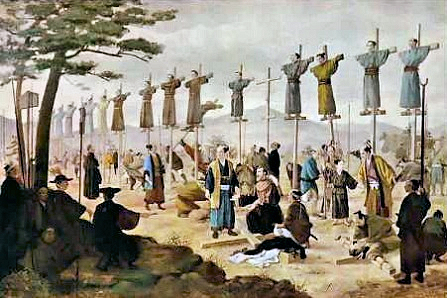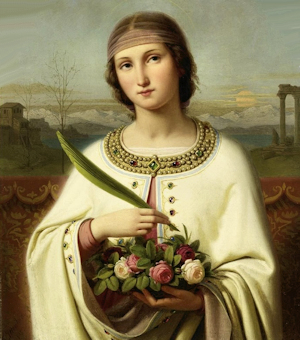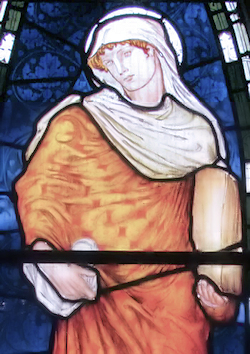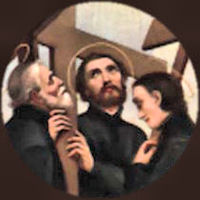Ordinary Time: February 6th
Memorial of St. Paul Miki and Companions, Martyrs
Other Commemorations: St. Dorothy, Virgin and Martyr (RM); St. Theophilus, Martyr (RM)
» Enjoy our Liturgical Seasons series of e-books!
Today is the Memorial of St. Paul Miki, a Japanese Jesuit, and his twenty-five companions (d. 1597), who were martyred in Nagasaki, Japan. They were the first martyrs of East Asia to be canonized. They were killed simultaneously by being raised on crosses and then stabbed with spears. Their executioners were astounded upon seeing their joy at being associated to the Passion of Christ.
The Roman Martyrology also commemorates St. Dorothy, Virgin Martyr (d. 300) and St. Theophilus, Lawyer and Martyr (d. 300), martyrs in Caesarea in Cappadocia. Although their story cannot be historically substantiated, these are an example of saints whose feasts were removed from the Universal Calendar but still commemorated as saints within the Roman Martyrology.
St. Paul Miki and Companions
Nagasaki, Japan, is familiar to Americans as the city on which the second atomic bomb was dropped, killing hundreds of thousands. Three and a half centuries before, twenty-six martyrs of Japan were crucified on a hill, now known as the Holy Mountain, overlooking Nagasaki. Among them were priests, brothers and laymen, Franciscans, Jesuits and members of the Secular Franciscan Order; there were catechists, doctors, simple artisans and servants, old men and innocent children—all united in a common faith and love for Jesus and his church.
 Brother Paul Miki, a Jesuit and a native of Japan, has become the best known among the martyrs of Japan. While hanging upon a cross Paul Miki preached to the people gathered for the execution: "The sentence of judgment says these men came to Japan from the Philippines, but I did not come from any other country. I am a true Japanese. The only reason for my being killed is that I have taught the doctrine of Christ. I certainly did teach the doctrine of Christ. I thank God it is for this reason I die. I believe that I am telling only the truth before I die. I know you believe me and I want to say to you all once again: Ask Christ to help you to become happy. I obey Christ. After Christ's example I forgive my persecutors. I do not hate them. I ask God to have pity on all, and I hope my blood will fall on my fellow men as a fruitful rain."
Brother Paul Miki, a Jesuit and a native of Japan, has become the best known among the martyrs of Japan. While hanging upon a cross Paul Miki preached to the people gathered for the execution: "The sentence of judgment says these men came to Japan from the Philippines, but I did not come from any other country. I am a true Japanese. The only reason for my being killed is that I have taught the doctrine of Christ. I certainly did teach the doctrine of Christ. I thank God it is for this reason I die. I believe that I am telling only the truth before I die. I know you believe me and I want to say to you all once again: Ask Christ to help you to become happy. I obey Christ. After Christ's example I forgive my persecutors. I do not hate them. I ask God to have pity on all, and I hope my blood will fall on my fellow men as a fruitful rain."
When missionaries returned to Japan in the 1860s, at first they found no trace of Christianity. But after establishing themselves they found that thousands of Christians lived around Nagasaki and that they had secretly preserved the faith. Beatified in 1627, the martyrs of Japan were finally canonized in 1862.
—Excerpted from Saint of the Day, Leonard Foley, O.F.M.
Highlights and Things to Do:
- The survival of Japanese Catholicism is one of the most moving stories in the entire history of the Church. For over two centuries the people had no priests but lived the faith as best they could, in secret, not daring to keep written materials but handing down their beliefs by word of mouth. (James Hitchcock, The Nagasaki Martyrs) You can read more in this article from Catholic Culture's Library, The Nagasaki Martyrs.
- Stop for a moment today to pray for Christians who are persecuted throughout the world.
- Read more about St. Paul Miki and Companions:
- View this video St. Paul Miki's Martyrdom.
- These martyrs' relics are in Nagasaki's Basilica of the Twenty-Six Holy Martyrs of Japan.
- CatholicSaints.info describes the Japanese style of crucifixion: "to put iron clamps around the wrists, ankles and throat, a straddle piece was placed between the legs for weight support, and the person was pierced with a lance up through the left and right ribs toward the opposite shoulder."
- Read Pope Pius XII's Encyclical Meminissee Iuvat on prayers for the persecuted Church.
- See Catholic Cuisine for some food suggestions for this feast day, including fortune cookies.
St. Dorothy of Caesarea and St. Theophilus
 St. Dorothy, (i.e., the gift of God), a virgin from Caesarea in Cappadocia, allegedly suffered a martyr's death under Diocletian. Her relics are honored in a church dedicated to her honor in the Trastevere section of Rome. (On the door of St. Dorothy's Church the names of those who had not received holy Communion during Easter time used to be posted.) Her feast was introduced into the Roman calendar during the Middle Ages.
St. Dorothy, (i.e., the gift of God), a virgin from Caesarea in Cappadocia, allegedly suffered a martyr's death under Diocletian. Her relics are honored in a church dedicated to her honor in the Trastevere section of Rome. (On the door of St. Dorothy's Church the names of those who had not received holy Communion during Easter time used to be posted.) Her feast was introduced into the Roman calendar during the Middle Ages.
A very edifying story is related in connection with her name. As Dorothy was being led to execution because of her faith in Christ, she prayed, "I thank You, O Lover of souls, for having called me to Your paradise." A certain Theophilus, a young lawyer and an official of the Roman governor, jestingly retorted, "Farewell, bride of Christ, send me apples or roses from your Bridegroom's garden of bliss." Dorothy answered, "I most certainly will."
 While devoting herself to prayer during the few moments permitted before receiving the death stroke, she beheld a vision of a beautiful youth who carried three apples and three roses in a napkin. She said to him, "I implore you to take these to Theophilus." Soon the sword severed her neck, and her soul returned to God.
While devoting herself to prayer during the few moments permitted before receiving the death stroke, she beheld a vision of a beautiful youth who carried three apples and three roses in a napkin. She said to him, "I implore you to take these to Theophilus." Soon the sword severed her neck, and her soul returned to God.
As Theophilus was mockingly telling his friend of Dorothy's promise, a young man stood before him holding a linen in which were wrapped three beautiful apples and three magnificent roses.
"See, the virgin Dorothy sends you these from the garden of her Bridegroom, even as she promised you." Highly astonished, for it was February and everything in nature was frozen, Theophilus received the gifts and cried out: "Truly indeed, Christ is God." And soon he too died a martyr's death for publicly confessing the faith.
—Excerpted from The Church's Year of Grace, Pius Parsch
Patronage: Brewers; brides; florists; gardeners; midwives; newlyweds; Pescia, Italy
Symbols and Representation: Crowned with flowers and surrounded by stars as she kneels before the executioner; crowned with palm and flower basket; surrounded by stars; crowned; carrying a flower basket; in an orchard with the Christ-child in an apple tree; leading the Christ-child by the hand; maiden carrying a basket of fruit and flowers, especially roses; roses; veiled with flowers in her lap; veiled; holding apples from heaven on a branch; with a basket of fruit and the Christ-child riding a hobby horse; with an angel and wreath of flowers; with an angel carrying a basket of flowers
Highlights and Things to Do:
- Read more about Dorothy and Theophilus:
- Decorate your table with red roses and a bowl of apples, and tell the story of Theophilus and Saint Dorothy to your family at dinner.
- According to the Catholic Encyclopedia it is a tradition in some locations to have blessing of trees on February 6 in honor of St. Dorothy and the blossoming fruit tree.
- See Catholic Cuisine's suggestion for an apple treat for today's feast.






